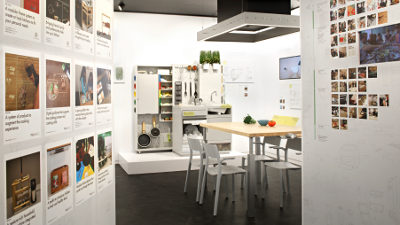Ikea is already well on the way to becoming the most techy furniture company out there – with it already implementing Qi wireless charging inside furniture. Now Ikea is going a step further by transforming the kitchen with connected devices.
The ‘Internet of Things’ is taking over, with Ikea hitting the ground running. The company’s vision for the future of kitchens includes networked devices, shelves that act as refrigerators, table tops that cook and instant food delivery by drones.
At the 2015 Milan Design Week in Italy, Ikea has been showing off what it believes will be the kitchen we use in the future.
Ikea wants to rid the kitchen of traditional appliances, like the refrigerator or stove, and replace those with multi-functioning spaces.
In its concept kitchen the company showed off how users could have cheese, milk and other perishable items on a shelf instead of a fridge.

The company also showed off inductive cooling containers, which will allow people to put individual items of food into containers, which can then be cooled to the exact temperature needed – rather than one overall temperature for everything.
These containers will work by reading an RFID sticker on the packaging of food, which means the consumer will not have to worry about consistently changing the temperature for individual items.
Ikea believes that whilst the kitchen of the future will include a lot more connected technology, it will often be more cost effective and in the long run save money.
By putting items in glass containers on shelves rather than in refrigerators, users will potentially be prevented from overbuying since it’s easier than ever to know what’s available and what needs to be bought.

At the heart of the kitchen Ikea envisions a worktop that can be used for everything from preparing food to cooking it to eating it.
The company has designed this tabletop by positioning a camera and projector above the table, while hiding induction coils underneath the surface.
Coupling these technologies together, the cameras can then detect where items are on the table and adjust the environment accordingly.
For instance, placing a frying pan on the surface will then cause the induction coils underneath to heat up that pan – and only that pan.
While that’s going on, the projector can create a screen around the pan displaying everything from recipes to a countdown timer telling users how long left until the food is prepared.
Once everything is cooked, users can quite easily pull up a chair and eat on the exact same surface – after all induction coils only make the pans hot, rather than the surface.

Another component of this concept kitchen is all to do with waste disposal.
Ikea wants people to be more responsible with their waste, implementing a compost system in its concept kitchen, which takes any organic waste washed away from the sink into this system.
The water is then extracted from this waste and compressed into a dry, odourless puck, which can then be taken away by local authorities or used in the garden.
While that’s what the company wants to happen to organic waste, the company’s other waste system sees a rack being implemented into the homes of Ikea customers.
This system will be able to scan bottles, cans and containers, which can then be crushed and depending on what it’s made of – recycled.
Waste will be vacuum packed and sealed in a bio-polymer tube, a thermo-printed label will record what’s been disposed of and list potential future uses, while those who waste less could be rewarded with an energy credit.
Ikea’s vision for the future of the kitchen also sees a change in how we treat water in 10 years time.
The company’s sink will feature two plug holes, pivoting one way for ‘grey’ water that can be reused for washing up and watering plants, while ‘black’ water will pivot the other way putting contaminated water into the sewage pipes for treatment.
So when will consumers be able to get their hands on Ikea’s kitchen of the future? Well, the company doesn’t see this technology coming into homes until at least 2025.
However with more ‘white goods’ manufacturers and interior companies becoming interested in connected technology, perhaps the smart home of the future will include as much tech in the kitchen as they now have in the living room.
Of course there are ways to have a connected kitchen right now, but for some of the more outlandish ideas, people will have to wait until this technology becomes a little more affordable.
More from Internet of Things
Slow Internet Is Being Caused By The Internet of Things, says Founder


